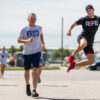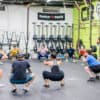How age impacts what youth strength and conditioning looks like:
Strength and conditioning programs have grown significantly over the years in younger populations as more parents and coaches look for ways to improve their athletes performance on the field. Because of the variety of athletic improvement that can occur through a focused strength and conditioning program we recommend it for anyone over the age of 8! The focus of a program is dependent on a child’s biological age; physical level of development, and training age; total time spent in a specific sport. For the majority of kids entering a youth program we can put them into three categories based on these two factors; pre-pubescence, pubescence and post-pubescence.
Pre-pubescence is time period before great shifts in growth and hormonal changes occur. This time is typically kids under the age of 12, but can be younger for early development that is typical of females. During this age the most diversity in experience level can occur. Some kids may have been in a specific sport since early childhood, such as little league through seasonal sport, while others may have just experienced their first team environment, middle school sport. No matter the prior level of training everyone at this age group is still developing significant strides in coordination and neuromuscular plasticity. This means a focused strength and conditioning program looks to increase the athletes’ coordination level to translate to safer, stronger movement on the field. While a strength focused program will not change the physical characteristics of muscles, get big and strong, a strength coach can provide a variety of exercises to increase an athlete’s ability to be more experienced and adapted to their sport. Abilities such as moving safer, showing more core to extremity control, learning to transmit power in a specific direction, and decreasing ground contact time all can occur at this stage.
Puberty begins the greatest physical changes in all athletes in this group based on when the onset of puberty actually occurs. Due to the the rapid changes in growth and hormones athletic ability has a high variance, some kids may even go through periods of decreased performance level as they adjust to the new changes. Athletes at this age can slowly be introduced to a purposeful strength based program while still focusing on developing as much variety in neurological drills as possible. A program may start with running mechanics, practicing ground contact time, speed and agility drills and move to lifting weights. Drills can become more complex at this stage as athletes are able to build mental and physical connections between drills and translation to their field sport.
Post-puberty consists of the late teen years. Athletes in this group have typically been in a strength and conditioning program for the long term with a goal to specialize in their sport after the school years. They may be going on to the collegiate or professional setting. This stage has the highest capability of tolerance to the demands of strength training. The drills and exercises chosen are highly specific to increasing the athletes abilities in their given sport. This is also the opportunity of a strength coach to prepare the athlete for the expectation of collegiate setting.
Youth strength and conditioning is an opportunity for athletes to develop a strong base of athleticism, prevent sport injury and increase the longevity of sport play. While not all kids may want to play a sport their whole life the level of neuromuscular adaptation that occurs in any program can be directly transferred to every day activity and function.
-Nicole Tsetsilas, CSCS, CF LV 2
CrossFit Kids Coordinator
Youth Strength and Conditioning





